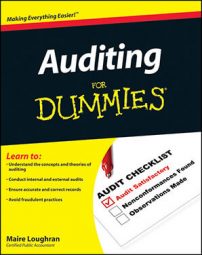If a potential auditing client’s records appear reliable and your firm can provide an impartial audit, you still need to make sure you can perform all the tasks the client needs. You also have to figure out what kinds of services to put in the contract.
Finding out what your client needs
While you interview the client, you can educate him about the nature of the services you provide. Previously unaudited companies tend not to understand that your firm can provide a wide range of auditing and assurance services.
After you speak with the client, you may realize that the company doesn’t really need a full-blown financial statement audit. For example, during the interview you may find that the company needs you to perform only specific agreed-upon procedures. For instance, you may be asked to confirm the cash on deposit or the valuation of the ending physical inventory.
Whatever the client’s needs are, your goal at this point is to get as many specifics as possible so your firm can determine whether it can meet those needs. You must also find out about the client’s reporting deadlines to make sure you can get the work done in time.
Following the standards for the type of audit
Want to know how to properly perform a service your client requires? Authoritative standards are set up for every task you’ll do as an auditor. Here’s a brief rundown of the basic nonpublic company standards:
Statements on Auditing Standards (SAS): SAS are pronouncements of the generally accepted auditing standards (GAAS).
Statements on Standards for Accounting and Review Services (SSARS): This authoritative source addresses services you provide that don’t rise to the level of an audit — for example, compilations and reviews.
Statements on Standards for Attestation Engagements (SSAE): These statements address the standards you must follow when examining, reviewing, or applying agreed-upon procedures to an assertion about a company fact, which is the responsibility of another party.
One example of an attestation engagement is break-even point analysis, which shows what volume of gross sales the company needs to cover all its expenses, both fixed and variable.
Fixed expenses remain constant no matter how much product the business sells. For example, rent expense doesn’t change whether the company sells one unit or a million.
Variable expenses go up and down depending on how many units the company sells. Direct material and labor are two types of variable expenses.
Your firm will have a current practitioner’s guide to GAAS that contains each of these standards. The American Institute of Certified Public Accountants (AICPA) website also contains info about the standards. College auditing textbooks usually provide abbreviated versions of the statements.
The Public Company Accounting Oversight Board oversees the auditors of public companies and has its own standards for audits.

